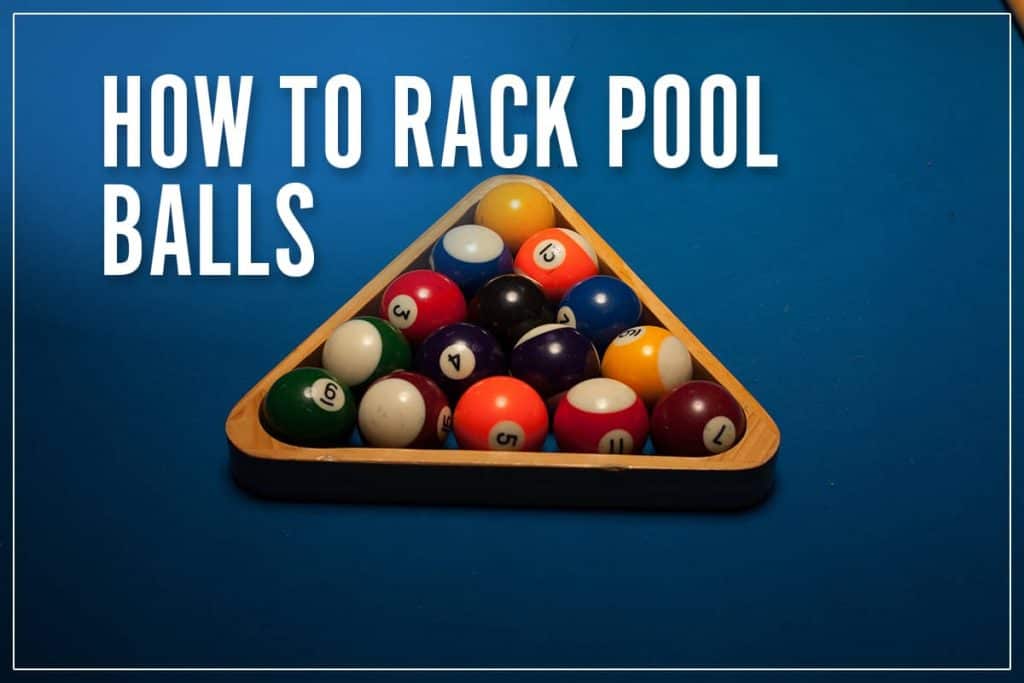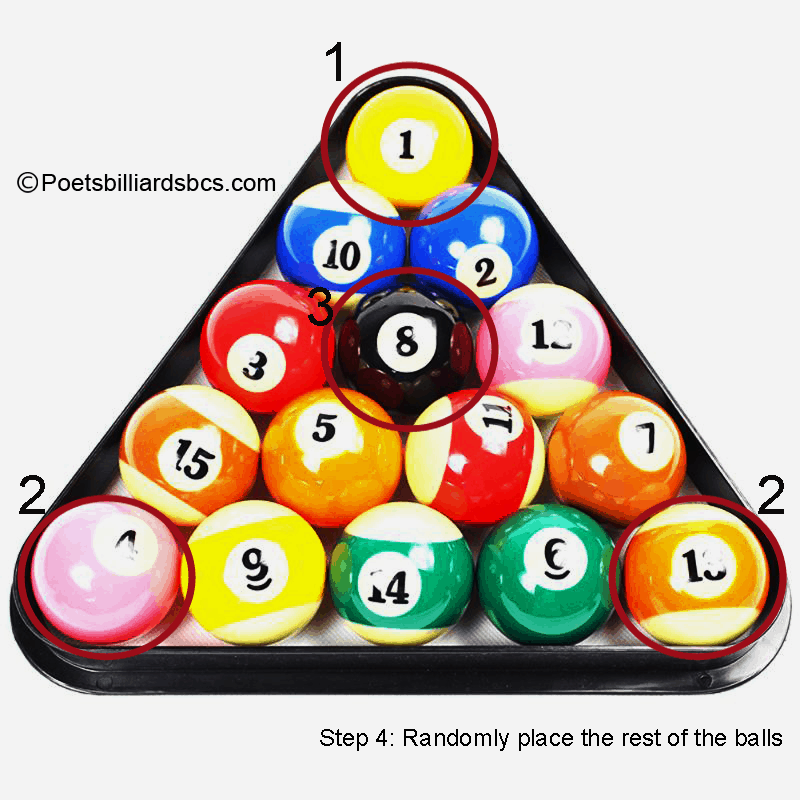Ever watched a pool game and wondered why some breaks seem to explode with power while others fizzle out? The secret to a winning break, and ultimately, a successful game, often lies in the seemingly simple act of racking the balls correctly.
The art of racking, often overlooked, is far more crucial than many casual players realize. It's the foundation upon which the entire game is built. A poorly racked set can lead to a weak break, leaving you at a disadvantage from the very start. Conversely, a meticulously arranged rack maximizes your chances of a strong, strategic opening. This article dives deep into the nuances of racking, providing you with the knowledge and techniques to master this fundamental skill. Well explore the key considerations, from the ideal ball placement to common mistakes to avoid, ensuring you're well-equipped to dominate the felt. We'll explore the essentials, explore different rules, discuss common mistakes to avoid, and give tips on perfect ball placement.
But what exactly is "racking" in the context of a pool game? Simply put, racking is the process of arranging the billiard balls on the pool table before a game commences. It involves using a specialized piece of equipment the pool rack, typically a triangle to position the balls in a compact formation, ready for the break shot. The goal is to create a tight, cohesive arrangement to maximize the impact of the break and provide a competitive start to the game. Most major pool games rely on proper racking. Racking up a game of pool is all about neatly positioning the object balls in the rack on the table.
This guide covers the essentials of racking pool balls, starting with the basics and moving to the advanced techniques. There are nine key considerations when trying to achieve the perfect rack, including placing the apex ball first, racking the balls tightly, manually locking the balls in, and tapping the balls down. We will also explore how to rack tables with different rules, followed by tips for perfect ball placement and common racking mistakes to avoid. Complete with illustrations, images of different racks, and even a video tutorial, this article ensures you master the art of racking in no time.
Mastering the art of racking is not just about knowing the rules; it's about understanding the underlying principles that govern ball placement and break strategy.
Let's delve into the practical aspects of racking, beginning with the most common variations.
Racking for 8-Ball Pool
The 8-ball pool rack is perhaps the most recognizable, with its distinct triangular arrangement. This game, one of the most popular pool variations, has specific racking requirements that are critical for a fair and balanced game. However, racking requirements can vary depending on the governing body that decides the underlying, therefore, it is important to be familiar with the regulations of the league or tournament you are participating in. Here's a breakdown of the standard 8-ball rack:
1. The Apex Ball: The apex ball (the one at the very front of the triangle) is crucial. It should be a solid color ball.2. The Center Ball: The eight ball (black) is placed in the center of the triangle.3. Alternating Solids and Stripes: The remaining balls are arranged in a pattern of alternating solids and stripes. There are no specific rules for the arrangement of the solids and stripes, as long as the 8-ball is in the center and the apex ball is a solid color. This is the standard for most games.4. Tight Rack: Ensure the balls are pressed tightly against each other to minimize gaps.5. Foot Spot: Place the racking triangle along the foot string of the table, with the apex ball centered over the foot spot.
Racking for 9-Ball Pool
9-Ball is a fast-paced game, the rack here is different than 8-ball pool. The diamond rack is used here and the goal is to pocket balls in ascending numerical order. Here's how to rack for 9-ball:
1. Diamond Shape: The balls are arranged in a diamond shape.2. Apex Ball: The one ball is positioned at the apex of the diamond.3. Nine Ball Center: The nine ball is placed in the center of the diamond.4. Random Placement: The remaining balls are placed at random, but make sure the one ball still leads at the apex, the ten ball is centered, and the remaining balls are again placed at random.5. Tight Rack: Ensure the balls are pressed tightly together.6. Foot Spot: Align the diamond so the one-ball is centered over the foot spot.
Racking for Straight Pool
Straight pool (also known as 14.1 continuous) has unique racking rules. The goal is to pot all 15 balls in a row, the rack is different than 8-ball pool and 9-ball pool because here, all 15 balls are racked at once, the balls are not racked in a specific order.
Here's how the straight pool rack works:
1. Random Arrangement: The 15 object balls are placed randomly within the triangle rack. There are no specific rules to set up the ball in any specific order, because of the random ball that will end up on the table in the end when all remaining 15 balls have been potted.2. Tight Pack: Ensure the balls are packed as tightly as possible.3. Apex Ball: The apex ball is not assigned a specific position, it's just one of the randomly placed balls.4. Centering: Center the rack on the foot spot.5. Break and Continue: The break shot scatters the balls. After the break, the player must pocket the balls one by one, calling each pocket, until a miss or a foul.
Essential Tips for Perfect Racking
Beyond the specific rules for each game, several universal principles can help you achieve a perfect rack every time:
1. Tightness is Key:
The most crucial factor in a good rack is tightness. Balls that are packed tightly transfer energy efficiently during the break, leading to a more powerful and predictable spread. To achieve this: Use a new or well-maintained rack. Older or warped racks might not create a tight formation. Press the balls firmly into each other while racking. Manually "lock" the balls in place, especially at the end, before removing the rack.
2. Proper Table Preparation:
Ensure the pool table is clean and level. A dirty or uneven surface can affect ball roll and the outcome of the break. Wipe down the felt regularly. Use a level to check the table's surface.
3. Alignment:
Make sure the rack is aligned correctly. The apex ball (or the one-ball in 9-ball) should be centered over the foot spot (a specific marking on the table). The foot spot is designed for correct positioning and ball distribution.
4. Racking Tools:
Consider using a racking template. These templates, often made of plastic or metal, provide a precise and consistent way to rack the balls. Templates ensure uniform ball placement. They help maintain a tight pack.
5. Break Strategy:
Understand that a good break involves more than just power. It requires strategic aiming and a knowledge of how the balls are likely to spread. The goal here is to maintain a tightly packed formation for the break. Practice aiming the cue ball at different angles to achieve the desired spread. Experiment with different break speeds to find the right balance of power and control.
Common Racking Mistakes to Avoid
Even experienced players make mistakes. Being aware of these common pitfalls can help you improve your racking skills. Loose Racks: Ensure the balls are packed tightly. Incorrect Alignment: Always center the rack properly. Worn Equipment: Use a quality rack, change it if necessary. Ignoring Rules: Know the specific racking rules for the game. Insufficient Practice: Practice racking regularly to develop muscle memory.
The Evolution of Racking
Up until the 1990\u2019s the way to set up the balls in the triangle is this: (Old rules pool ball rack set up). This rack is also used for leagues and players that play old EPA rules (pub rules).
By understanding the nuances of racking, you'll significantly enhance your pool game. Embrace these techniques, and you'll be well on your way to a more strategic and successful break. Remember that practice is crucial. Correctly rack pool balls with help from a professional pool player in this free video. There are different racks for different pool games, but you always want to make sure, most major pool games use a pool rack to ensure the balls are tight and that you get a good, competitive start. As you continue to refine your skills, you'll find yourself not only racking the balls better but also developing a deeper appreciation for the strategic complexities of the game.
Racking is simply the process of placing the billiard balls on the pool table before a game. This classic rack shape is designed to hold and organize the balls in a compact, triangular formation, which helps ensure they are set up correctly for a fair and balanced game. Cuesports magic ball rack 8, 9, and 10 ball combo pack (standard) view on amazon.



Detail Author:
- Name : Prof. Tomasa Reynolds II
- Email : jjakubowski@cronin.biz
- Birthdate : 1998-03-13
- Address : 956 Witting Centers Apt. 513 West Berthaborough, AZ 14259
- Phone : +1-401-680-2747
- Company : Cummerata and Sons
- Job : Photographic Reproduction Technician
- Bio : Fuga facilis veritatis similique et laudantium tempora voluptatibus. Dolorem quo rerum aliquam aliquid porro. Eos eum voluptatum officiis voluptatem dolor. Eos ab doloribus est quia cum.